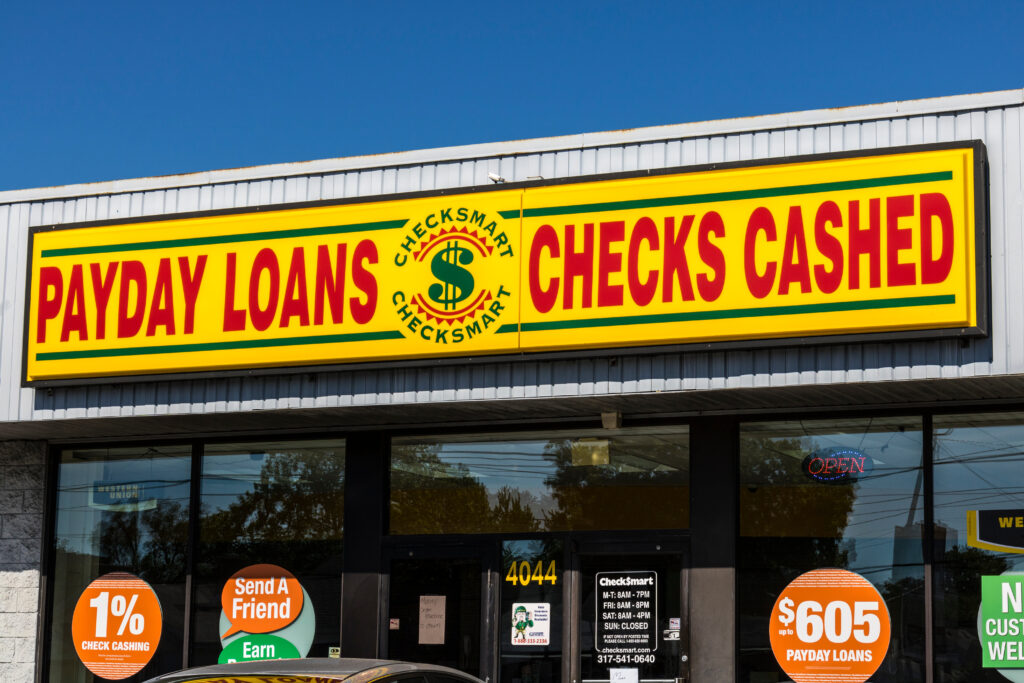What is predatory lending?
Lenders are considered predatory when they use practices that involve fraudulent, unfair, and abusive loan terms, including ultra-high interest rates and fees, aggressive and deceptive sales tactics, and terms that rob borrowers of their equity. Predatory lending can take many forms, but the most common include payday loans, car-title loans, and subprime mortgages. A more recent development are “rent-a-bank” schemes that exploit loopholes to get around predatory lending laws. Predatory lenders intentionally target vulnerable populations, luring people into taking out loans they can’t afford, with the ultimate goal of trapping them in debt.
Why is it important?
Predatory lending harms already vulnerable people and the communities they live in
- Predatory lenders target people struggling to pay their bills, people who have recently lost their jobs, and those subject to discriminatory lending practices because of their race, ethnicity, age, disability, or lack of higher education.
- The effects of predatory lending are magnified in communities with low income, where bankruptcies and foreclosures can drag down whole neighborhoods. Although the practice of “redlining” – financial and housing discrimination aimed at communities of color – was outlawed decades ago, predatory lenders now target those same areas in what’s referred to as “reverse redlining”.
- The effects of discriminatory and predatory lending practices linger for generations and worsen the racial wealth gap. Despite fair housing laws, people of color still face higher interest rates, lower loan approval rates, lower home ownership rates, and lower personal wealth.
- Predatory lenders also target women – especially women of color – regardless of their income. During the subprime mortgage crisis in 2005, women were 30 to 46 percent more likely to receive a subprime mortgage. Black women were 256 percent more likely than a white male to receive one. Today, 60 percent of payday loan customers are women.
- Payday and car-title lenders alone drain $8 billion per year from local economies. Far more concerning is the unknown billions drained by illegal online lending.
Predatory lenders profit from and contribute to personal crisis and misfortune
- 80 percent of payday loans are renewed multiple times. With new fees added to each new loan, debt quickly spirals out of control. The use of payday loans doubles the rate of personal bankruptcy.
- One in five car-title loan borrowers end up having their vehicle seized.
- US households used about a third of their COVID-19 stimulus money to pay down debt. For families earning less than $40,000 per year or without a college degree, the share was closer to 40 percent. As a result, payday lenders earned record profits during the pandemic.
Predatory lenders exploit loopholes to dodge consumer protection laws
- In the height of the COVID-19 pandemic, rules requiring lenders to determine the ability of customers to repay high-cost loans were substantially rolled back, and new rules making it easier for predatory lenders to partner with national banks were established. These actions set the stage for “rent-a-bank” schemes that bypass state laws designed to prevent predatory lending.
- Predatory lenders use “rent-a-bank” schemes to charge interest rates of 100 percent or more even in states that set the strictest small dollar loan rates at 36 percent.
How are Mainers impacted?
Maine significantly improved protections against predatory lenders by eliminating car-title loans, capping the interest rate on payday loans under $2,000 at 30 percent, and outlawing rent-a-bank schemes. But Maine law allows payday lenders to charge fees every two weeks for the term of the loan. While these fees of $5 to $25 may seem small, they quickly add up. In just six months, a $250 loan can double in size, effectively turning a 30 percent interest rate into a 261 percent interest rate.
Additionally, predatory lenders continue to work to undermine these protections such as potential new efforts to modify or roll back consumer protections that threaten an opening for “rent-a-bank” schemes to take hold in Maine, essentially allowing lenders to launder loans in states that allow ultra-high interest rates. Illegal online lending is also of concern, and little is known about its impact in Maine.
As rising prices put pressure on the ability of Mainers with low income to make ends meet, more people could be enticed by these risky debt traps. In a recent survey, 42 percent of respondents in Maine found rising prices very stressful, and two thirds reported difficulty paying for household expenses.
What are the solutions?
- While Maine’s 30 percent interest rate cap on payday loans under $2,000 is strong consumer protection, lenders’ ability to charge high fees can erase the cap’s benefit. Maine lawmakers should close the fee loopholes to create an all-inclusive 30 percent cap.
- Maine explicitly prohibited “rent-a-bank” schemes in 2021. Maine lawmakers must now reject efforts to overturn or modify them.
- Congress should pass a national 36 percent interest rate cap on all lenders and banks in every state.
- The FDIC should prohibit rogue banks from utilizing predatory “rent-a-bank” schemes.
- The Consumer Finance Protection Bureau should implement regulations requiring lenders to determine the ability of a borrower to pay, limit the time lenders can keep borrowers in debt, and prohibit lenders from requiring electronic access to a borrower’s bank account.
- Federal regulators — including the Department of Justice, the Federal Trade Commission, and the Consumer Financial Protection Bureau — should use their authority to crack down on illegal online lending.
Did you know…?
- Nationwide, interest rates for payday loans typically range from 390 to 780 percent. For comparison, the average interest rate on a credit card is about 24 percent.
- 18 states and the District of Columbia cap payday loan interest rates at 36 percent.
- “Rent-a-bank” schemes are often found operating through pet stores, auto mechanics, and furniture stores.
- In 2021 there were more payday lenders in the US than there were McDonalds.
- 12 million Americans use payday loans each year.
- Half of the revenue in payday lending is generated by online and app-based lending.
- Payday lenders collect 75 percent of their fees from borrowers with ten or more loans per year. Trapping people in debt is their business model.
Dive deeper
Maine Must Continue its Clampdown on Predatory Lenders | Maine Center for Economic Policy
Consumer-Lending Discrimination in the FinTech Era | UC Berkely
Charging 589% Interest in the Pandemic is a Booming Business | Bloomberg
How Payday Loans Work | Consumer Federation of America
Legal Status of Payday Loans by State | Consumer Federation of America
36% Cap on Annual Interest Rate Stops Payday Lending Debt Cycle | Center for Responsible Lending
What is the Racial Wealth Gap? Definition, Statistics, and Impact | Investopedia
Pinklining – How Wall Street’s Predatory Products Pillage Women’s Wealth, Opportunities & Futures
Short-Term, Small-Dollar Loan Study | Maine Bureau of Consumer Credit Protection




